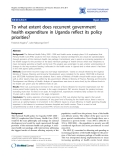
Health care expenditures
Xem 1-1 trên 1 kết quả Health care expenditures
-
Tuyển tập các báo cáo nghiên cứu về y học được đăng trên tạp chí y học Critical Care giúp cho các bạn có thêm kiến thức về ngành y học đề tài: To what extent does recurrent government health expenditure in Uganda reflect its policy priorities?
 7p
7p  coxanh_4
coxanh_4
 27-10-2011
27-10-2011
 36
36
 4
4
 Download
Download
CHỦ ĐỀ BẠN MUỐN TÌM
TOP DOWNLOAD














